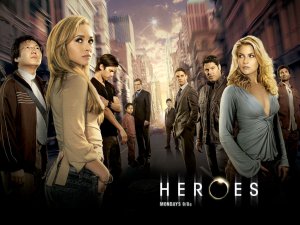by Paul Salzer
Heroes, superheroes in particular, seem to be making a comeback in recent years. Movies, television shows, and even musicals have exploded out from the pages of comic books worldwide. Last night, I even happened across a new superhero show called The Cape on NBC. The show intrigued me at first because of Orwell, played by Summer Glau (who incidentally had also voiced the character of a superhero in a recently released DC cartoon).
Glau peaked my interest because I have seen her previously on shows like Firefly, The 4400, Dollhouse, and Terminator: the Sarah Connor Chronicles. With The Cape, she may have cemented herself solidly as someone to know if you reside in the Geekverse such as me. Her character’s name along with the reference, “Orwell is watching” should make any Geek giggle for joy.
Hopefully The Cape will not follow the path of another superhero show that NBC aired a few years ago called Heroes. That show’s first season (and part of the second) was phenomenal! I and countless happy viewers praised the show for its originality, its characters, and its story. There was a time when Geeks were ready to elevate Heroes to very near the pinnacle of the Geekverse’s Pantheon of Shows along with Buffy the Vampire Slayer, Lost, and Battlestar Galactica.
So how does all this relate to business? What is the link between innovation and a show about extraordinary people doing extraordinary things? Simple stated; the demise of the show Heroes highlights why innovative strategy can fail in businesses. Let’s take a closer look at what made Heroes great and what made it stink worse than rotting cauliflower left a the counter for several weeks.
The first season was “tight”. Although there were three or four different subplots going, these individual plotlines always appeared to be moving toward a singular point of convergence later in the season. After the first season, however, the show introduced plotlines that appeared to go nowhere (almost to the point of being counterproductive to the overall story). As the plot lost focus, so did the audience, and eventually enough audience members lost interest for the network to cancel the show after the fourth season. The same is true about innovative ideas. Business can have multiple ideas and projects going at the same time, but it is important that these ideas keep to a singular goal.
A good way to accomplish this is by drafting a mission statement early on. A mission statement is the guiding principle or principles that govern the direction of a project. Before starting any new innovation project this year, create a mission statement which defines your main goal for innovating. Why do you want to innovate? What should the end result be when the innovation projects are completed? In your mission statement, you can also outline the means of how you want projects to be handled throughout the year (or longer, if necessary). Basically, a good mission statement will prevent you from deviating too far from your company’s overall goals. And more importantly, it should prevent you from embarking on projects that are counterproductive to those goals. Innovation for the sake of innovating is not a smart practice. You need to temper your innovative endeavors with direction and focus.
Great characters are another reason why Season 1 of Heroes was great. We were introduced to nearly a dozen characters over the course of the season, but each character was given time to develop and we were able to see how each related to one another. In the later seasons, we were constantly introduced to new characters, most of which never had time to develop. Some left you wanting more. Others made you wonder why that character was even introduced. Sadly though, some even took the focus away from the beloved characters that we invested our time with in Season 1.
The same is true with innovative ideas. It is important to give your ideas time to develop and it is equally important that you not get distracted by other ideas. It is vital that brainstorming only takes place in the early stages of an innovation project. Introducing new solutions in the later stages could potentially derail the entire project. If a great idea should come up late in a project, table the idea for a later day.
The number one reason why Season 1 was great though is that the show really stuck with its premise no matter how silly it sounded at first. Who would have ever thought that “Save the cheerleader save the world” would be a workable idea. Yet, the show never deviated from that message during the season, and worked hard to sell the idea. Throughout the season, it appeared and reappeared. It was on promotions and on the lips of talk show hosts around the country. It almost became a pseudo battle cry for Geeks. Heck, you can still find T-shirts with that saying on it. The later seasons never recaptured the magic of that phrase in Season 1. In Season 3, the show even tried making some of the characters villains and vice versa with a story arch (volume) called Villains, but then back peddled later in the season with a volume called Fugitives, and eventually to Season 4 which they entitled Redemption.
Innovative solutions (like catchy promotional selling points) die without the support of someone, usually the committee that proposed that solution. Once an innovation project is complete, it is important that everyone on the committee agrees to promote that solution, even if they personally do not agree with it. The committee needs to sell the premise of the solution no matter how silly it sounds at first. If the idea was discussed and developed correctly, there shouldn’t be many reasons for not implement the solution. The time to debate issues with a solution is during the developmental stages of the solution; not after the solution is ready to be presented to others. Companies around the world have seen solutions fail because a former committee member undermines the unveiling of the solution through gripes and by not personally following through with the solution themselves.
In the case of Seasons 3 and 4, I think the show had potential with its villain/hero role reversal idea. But the show hadn’t embraced the idea like they did with “Save the cheerleader…” In fact, my first impressions of those seasons came from friends who complained it was a stupid idea. I think they heard the same from their friends. Had NBC fully campaigned for the notion that heroes can be villains at times and villains can be heroes, I think we would still be watching new episodes of Heroes and praising how fresh it is to see the lines blurred for a change. I guess there’s still The Cape though. Just remember network television executives, “Big [Audience] is watching!”



Pingback: Thill Logisitcs